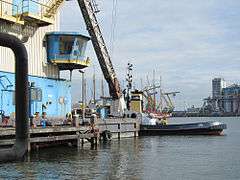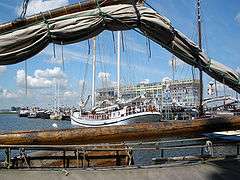Port of Amsterdam
| Port of Amsterdam | |
|---|---|
|
| |
| Location | |
| Country | Netherlands |
| Location | Amsterdam |
| Coordinates | 52°24′43″N 4°48′28″E / 52.4120°N 4.8079°E |
| Details | |
| Opened | 13th century |
| Operated by | NV Haven Amsterdam[1] |
| Owned by | Amsterdam[1] |
| Size of harbor | 620 ha (1,500 acres)[2] |
| Land area | 1,995 ha (4,930 acres)[2] |
| Employees | 54.000 (2011)[3] |
| President & CEO | Dertje Meijer[3] |
| Statistics | |
| Vessel arrivals |
|
| Annual cargo tonnage |
|
| Passenger traffic |
|
| Annual revenue |
|
| Net income |
|
|
Website www | |
The port of Amsterdam (Dutch: Haven van Amsterdam) is a seaport in Amsterdam, the Netherlands. It is the 4th port in Europe by metric tonnes of cargo. The port is located on the bank of a former bay named the IJ and the North Sea Canal, with which it is connected to the North Sea. The port was first used in the 13th century and was one of the main ports of the Dutch East India Company in the 17th century. Today, the port of Amsterdam is the second largest port in the Netherlands, the largest being the Port of Rotterdam. In 2014, the port of Amsterdam had a cargo throughput of 97.4 million tons, most of which was bulk cargo.[3]
History

The first port activities in Amsterdam date back to the 13th century. The port was first mentioned in the year 1342, when the city of Amsterdam received city rights.[5]
In the Dutch Golden Age the port was one of the main harbours of the Dutch East India Company.[5]
The North Holland Canal, that connects Amsterdam to Den Helder was dug between 1819 and 1824. The North Sea Canal, that connects Amsterdam to IJmuiden, was dug between 1865 and 1876.[5]
Geography

The port of Amsterdam is located on the banks of the North Sea Canal and the IJ. The port is connected to the North Sea through the North Sea Canal, to Den Helder through the North Holland Canal, to the Markermeer through the IJ and the IJmeer, and to the Rhine through the Amsterdam-Rhine Canal.
In total, the port comprises 620 ha (1,500 acres) of waterways and 1,995 ha (4,930 acres) of land area, including port estates, quays, roads, railway tracks, ditches and green space.[2]
The port comprises several harbour areas, which are part of the boroughs (Dutch: stadsdelen) Westpoort, Westerpark, Centrum, and Zeeburg. From west to east the areas are:[6]
- Afrika Harbour (Dutch: Afrikahaven)
- Amerika Harbour (Dutch: Amerikahaven)
- West Harbour (Dutch: Westhaven)
- Jan van Riebeeck Harbour (Dutch: Jan van Riebeeckhaven)
- Petroleum Harbour (Dutch: Petroleumhaven)
- Coen Harbour (Dutch: Coenhaven)
- Mercurius Harbour (Dutch: Mercuriushaven)
- Hout Harbour (Dutch: Houthaven)
- De Ruijter Quay (Dutch: De Ruijterkade)
- Eastern Trade Quay (Dutch: Oostelijke Handelskade)
- Eastern Harbour Area (Dutch: Oostelijk Havengebied)
Business operations
In terms of cargo throughput, the port of Amsterdam is the second largest port of the Netherlands after the port of Rotterdam.[7]
In 2008, 6,029 sea vessels visited the port of Amsterdam, with a cargo throughput of 75.8 million tons, most of which was bulk cargo. That same year, the total container volume was 435,129 TEU. Both the number of vessels and the bulk cargo and container throughput increased compared to 2007.[8]
In 2008, 117 sea cruise ships called at the port with a total of 226,000 passengers. Also 998 river cruise ships with 170,000 passengers visited Amsterdam's port. The number of sea cruises and their passengers increased significantly by 50% compared to 2007, whereas the river cruise traffic slightly declined.[8]
In 2008, the total revenue was € 125.3 million and the net income € 45.0 million. This is a minor decrease compared to the revenue and income in 2007.[8]
In 2008, the port itself had 361 employees, but the number of indirect employees is circa 55,000.[8] On 7 July 2009, Mrs. Dertje Meijer was appointed as the director of the port by the government of Amsterdam.[9]
Goods
Bulk cargo: the port of Amsterdam is the biggest dry bulk port in Europe, which most was coal and gasoline, Amsterdam is the biggest gasoline port of the world. Amsterdam is also the biggest cocoa port in the world. There are in Amsterdam many terminals for bulk cargo.
Containers: Amsterdam is a more important port in Western Europe for Containers, with not very much terminals and 1 bankrupt terminal in the Amerikahaven (Americaharbour). In 1998 the harbour alderman from Amsterdam came into contact with "Mr. Container" Kristos Critikos from the Ceres shipping company. They had a plan to build a container terminal in the port to compete with the port of Rotterdam. In 2000 the terminal was ready for use, but there were no customers for the brand new deep-sea terminal until 2005 when Nyk-line from Japan started a service between Amsterdam and Asia. But 3 years later, in 2009, the shipping company shut its service in Amsterdam. In 2012 the terminal was bankrupt.
Breakbulk: Amsterdam is the third biggest breakbulk port in Western Europe. There are very much terminals for breakbulk.
Food: the port of Amsterdam is world's largest cocoa port. The port of IJmuiden is a European hub for fish, and the port of Beverwijk is a big port for fruit and potatoes.
Cruises: Amsterdam is the 4th cruise port in North-Western Europe with more than 150 cruise ships every year, of which most have destinations in Europe, the Caribbean and North America.
International cooperation
The port of Amsterdam has a connection with the ports of the following cities:[10]
 Port of Accra, Ghana
Port of Accra, Ghana Port of Beijing, China
Port of Beijing, China Port of Cape Town, South Africa
Port of Cape Town, South Africa Port of Halifax, Canada (Until 2019)
Port of Halifax, Canada (Until 2019) Port of San Pédro, Côte d'Ivoire
Port of San Pédro, Côte d'Ivoire Port of Tianjin, China
Port of Tianjin, China Port of Xiamen, China
Port of Xiamen, China Gwangyang Bay Free Economic Zone, South Korea (2018)
Gwangyang Bay Free Economic Zone, South Korea (2018)
Gallery
-

Neptunushaven
-

Houthaven
-
The Poseidon, tugboat at the port
-
_CERES_-_Flickr_-_Joost_J._Bakker_IJmuiden.jpg)
Alaskahaven (containers)
-
Zanzibarhaven
-

Passengers terminal
-
Heliport in the port
References
- 1 2 Frequently Asked Questions, Port of Amsterdam, 2013. Retrieved on 2013-05-21.
- 1 2 3 Factsheet Sites & space, Port of Amsterdam, 2013. Retrieved 2013-05-21.
- 1 2 3 4 5 6 7 8 Annual Report 2011, Port of Amsterdam, 2012. Retrieved on 2013-05-21.
- ↑ Port of Amsterdam, annual report 2014
- 1 2 3 The port of Amsterdam. Port of Amsterdam. Retrieved on 2009-07-17.
- ↑ Portmap. Port of Amsterdam. Retrieved on 2009-07-17.
- ↑ (Dutch) Jaarverslag 2008. Nationale Havenraad. Retrieved on 2009-07-23.
- 1 2 3 4 Annual report 2008. Port of Amsterdam. Retrieved on 2009-07-17.
- ↑ Dertje Meijer, new director Port of Amsterdam. Port of Amsterdam. Retrieved on 2009-07-17.
- ↑ Bureau Internationale Betrekkingen. City of Amsterdam. Retrieved on 2009-07-01.
External links
| Wikimedia Commons has media related to Port of Amsterdam. |
- Port of Amsterdam, official website
| ||||||||||